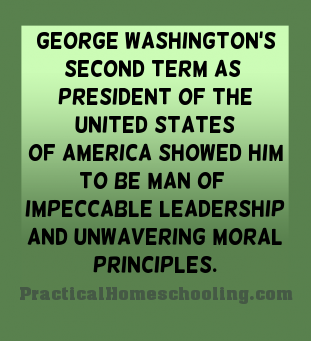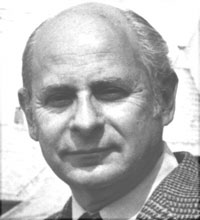George Washington: Our First President’s Second Term
By Sam Blumenfeld
Printed in Practical Homeschooling #86, 2009.
 President during the French revolution - George Washington: Our First President’s Second Term
President during the French revolution - George Washington: Our First President’s Second Term

| 
|
 On March 4, 1793, George Washington was inaugurated for his Second
Administration at Federal House, Philadelphia. John Adams was elected
Vice President, and the Cabinet posts were held by the same men as in
the First Administration. Although he had been reluctant to serve a
second term, Washington gave in to the pleadings of Madison, Jefferson,
and others who argued that without him at the helm, the Union might
break apart.
On March 4, 1793, George Washington was inaugurated for his Second
Administration at Federal House, Philadelphia. John Adams was elected
Vice President, and the Cabinet posts were held by the same men as in
the First Administration. Although he had been reluctant to serve a
second term, Washington gave in to the pleadings of Madison, Jefferson,
and others who argued that without him at the helm, the Union might
break apart.
In the 3rd Congress (1793-95) there were 17 Federalists and 13
Democratic-Republicans in the Senate, and 48 Federalists and 57
Democratic-Republicans in the House. In the 4th Congress (1795-97) there
were 19 Federalists (Tennessee had joined the Union) and 13
Democratic-Republicans in the Senate. In the House the Federalists
increased their numbers from 48 to 54 and the Democratic-Republicans
were down from 57 to 52.
On July 31, 1793, Thomas Jefferson resigned as Secretary of State after
President Washington accepted Hamilton’s advice on foreign affairs. The
French Revolution had begun in 1789 and in September 1792 the French
monarchy was abolished. Jefferson, who had been ambassador to France,
tended to favor the Revolution while Hamilton was critical of the
Revolution’s reign of terror.
Hamilton and Jefferson also disagreed on the basic philosophy of
government. Jefferson saw the U.S. as an agrarian nation with as much
decentralized democratic freedom as possible, while Hamilton,
preoccupied with finding the financial means to sustain a strong federal
government, favored a nation of thriving cities and new industries.
In November 1792, the British began seizing American ships carrying
French goods in the West Indies and impressing (kidnapping and forcibly
enlisting) American sailors into the British Navy. Washington then sent
John Jay, Chief Justice of the Supreme Court, to Great Britain seeking
British withdrawal from the Northwest, an end to the impressment of
American sailors, compensation for slaves seized during the American
Revolution, and restoration of trade rights in the West Indies.
Congress also passed the Neutrality Act, forbidding U.S. citizens from
enlisting in the service of a foreign government. The French government
had hoped to use American seamen to serve as mercenary privateers
against British shipping in the West Indies.
In November 1794, Britain signed Jay’s Treaty, agreeing to withdraw its
troops from the Northwest Territory by 1796. It also agreed to pay the
U.S. $10 million in reparations for seized ships. In return, the U.S.
agreed to settle pre-Revolutionary War debts owed to British creditors.
When the terms of the agreement were made public in March 1795, Southern
planters were outraged at the Treaty’s failure to compensate them for
the loss of their slaves. Nevertheless, the Senate ratified the Treaty
and Washington reluctantly signed it.
As the end of his second term neared, Washington rejected the idea of a
third term. He felt that he had done his duty to the new nation and that
he could finally retire to his beloved Mount Vernon.
On September 19, 1796, America’s first President gave his Farewell
Address. In it he warned his fellow citizens of the dangers of becoming
involved in “entangling alliances” with foreign countries. He also
stressed the importance of maintaining the Union despite regional
differences. He said:
“The unity of government which constitutes you one people is also now
dear to you. It is justly so, for it is a main pillar in the edifice of
your real independence, the support of your tranquility at home, your
peace abroad; of your safety; of your prosperity; of that very liberty
which you so highly prize. [I]t is of infinite moment that you should
properly estimate the immense value of your national union to your
collective and individual happiness; watching for its preservation with
jealous anxiety; discountenancing whatever may suggest even a suspicion
that it can in any event be abandoned.
“The name of American, which belongs to you in your national capacity,
must always exalt the just pride of patriotism more than any appellation
derived from local discriminations.These considerations speak a
persuasive language to every reflecting and virtuous mind and exhibit
the continuance of the Union as a primary object of patriotic desire.”
Yet, only sixty years later, the nation was rent in two by the Southern
Secessionists, who obviously had forgotten Washington’s sound warnings
and advice. The result was a horrendous Civil War, the destruction of
the South, and the deaths of almost a half-million soldiers.
Washington died on December 14, 1799. But before dying, he freed his
slaves. He abhorred the slave system because of its basic inhumanity and
hoped that it would gradually disappear. But it took a Civil War to
finally get rid of it.
Education expert Sam Blumenfeld’s Alpha-Phonics reading program is
available on www.samblumenfeld.net. His latest book, The
Marlowe-Shakespeare Connection, is about the Shakespeare authorship
mystery.